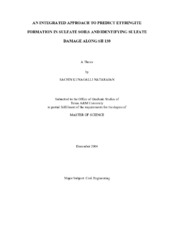| dc.description.abstract | Expansive soils are treated with anhydrous or hydrated lime. The use of calcium-based stabilizers such as calcium oxide (lime) in sulfate-bearing clay soils has historically led to distress due to the formation of an expansive mineral called ettringite and possibly another such mineral, thaumasite. Predicting the precipitation of these minerals is a complex problem related not only to soil composition but also construction methods, availability of water, ion migration, and whether the expansive mineral growth can be accommodated by the void structure in the surrounding soil. In trying to control the damage associated with such occurrences, engineers have attempted to determine a threshold value of soluble sulfates, a quantity that is relatively easy and quick to measure, at which significant ettringite growth and, therefore, structural distress occurs. Unfortunately, experience alone and “rules-of-thumb” based on experience are not sufficient to deal with this complex issue. This thesis describes how thermodynamic geochemical models of lime-treated soil can be used as a first step toward establishing problematic threshold levels of soluble sulfates for a specific soil. A foundation for the model development is presented, and two different soils are compared to illustrate their very different sensitivities to ettringite growth upon the addition of hydrated lime.
Various soil series along the route of SH 130 between Austin and San Antonio have been identified to contain soluble sulfate that may pose a problem for soil stabilization using lime and cement. Since the model predicts ettringite growth based upon site-specific properties, this thesis also shows how the model can be used to assess the potential amelioration effects of soluble silica.
Research was conducted at the Texas Transportation Institute to develop a methodology for identifying areas which are susceptible for ettringite formation. The proposed methodology uses a magnetometer to quickly screen large areas for high sulfate. Application of GIS to identify ettringite formation using soils, topographical, and geological maps is also illustrated in this thesis. | en |


